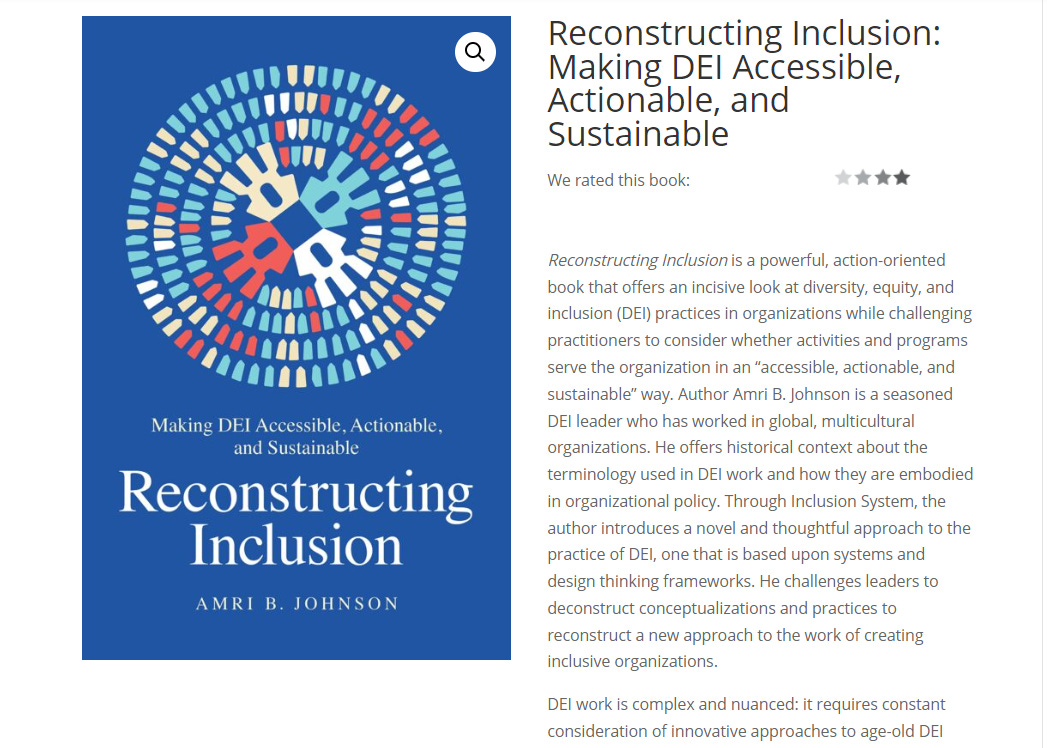Our Interpretation of Information is closer to Exformation
What seems like intentional acts of exclusion could simply be, and probably often are, that we have disparate exformation.
Here are two ideas from my book, Reconstructing Inclusion: Making DEI Accessible, Actionable, and Sustainable and other texts I leaned on in writing it. In addition, I’ve included one quote, a book recommendation, and a video or article that has inspired or influenced me and hopefully will resonate with you, too. (That’s ✌🏿+ 💡📚➕).
Page 156-157
Exformation is discarded information. “Exformation is what is [excluded] en route, before expression,” says author of The User Illusion, Tor Nørretranders.
"Nørretranders’s book title comes from a term coined by computer scientists at the Xerox Palo Alto Research Center based in Palo Alto, California. Scientists determined that it doesn’t matter if someone using a computer knows how it works. Users want to use computers as tools to meet their objectives.
The “user illusion” is why software programmers, app developers, website architects, and marketers spend a considerable amount of time iterating and improving on the user interface or UI of their digital product or product consumed with digital tools. UI, as it has evolved, has expanded to UX or the overall user experience. Those in the UI/UX space generally are not doing their job to help users of their products, services, and interfaces understand what goes into creating what they deliver. They do what they must to make sure the user gets what they need out of the creation.
There’s clarity (often on both sides) that the depth of what goes into a creation is far vaster than what comes out of it. Let’s use the example of a video game. Gamers may know that a great amount of sophisticated code is on the game’s insides. Some may care. Most only care about the experience of playing against their friends, colleagues, and competitors around the world.
Related post: Inclusion is a relational construct

They are concerned about perception, and that is the essence of consciousness— perception is where consciousness lives. The user illusion makes it clear that perception is a sort of incomplete reality. In most cases, individuals take what they need, and no further “reality” is necessary. The illusion is sufficient. . . Nørretranders equates the user illusion with consciousness.
He states, “Our consciousness is our user illusion for ourselves and the world. . . .The user illusion is one’s very own map of oneself and one’s possibilities of intervening in the world.” The second sentence above makes consciousness sound a lot like agency. Does consciousness give us a sense of control or lack thereof? Or is the iteration of eleven million bits per second of information that needs to be discarded to conclude how one’s level of control or sense of agency occurs to oneself?"
Nørretranders states, “We have no idea of the exformation in most of the messages we hear. We, guess, sense, and support--but we do not know.” The author continues conveying that we can’t know the exformation of every interaction. Those delivering the message don’t know themselves. In some cases, a message can occur as an act of exclusion.
But what if what seems like intentional acts of exclusion could simply be, and probably often are, that we have disparate exformation.”
Related video: Are you willing to be influenced by the so-called “other”?
Page 157-158
“Our framing for exclusion can be different. What seems like acts of exclusion could simply be, and probably often are, that we have disparate exformation.
Let’s say you are in a meeting with a total of eight people, including yourself. You are leading and facilitating the meeting about a project that is moving into its final phase. While you have worked with five of the people in the meeting quite a bit throughout this eighteen-month project, three are new and have specific expertise needed for this phase. This is the fifth weekly meeting with the new and older team members.
Everyone has access to communications and files since the project’s inception via the collaboration platform. In essence, much of the information is there for their consumption. The three new members shared before the first meeting with you that they were up to speed on the project plan and have read what comes next. During the meeting, you are excited as usual, articulating the critical nature of the current phase and the necessity to make sure all moves fluidly forward.
You set critical tasks to be done, primarily by the new team members, given their expertise being most relevant at present. A few days later, when expecting feedback from the new team members, they don’t come to you when expected and you’re slightly annoyed as a result. To assure that you were clear about your requests, you reach out to the team members you have been working with for a while and ask them if what you said was clear. Two of them confirm that what you asked for was unambiguous. You quietly feel like your exasperation is justified.
Related post: Centering Nuance in DEI
Reconstructing Inclusion S1E10: DEI Work Means Skin in the Game (Otherwise, It’s Just Posturing)
Subsequently, you have a meeting with a colleague who goes on and on about the level of work and detail your new team members are putting into the project. She shares how energized they are by you and how much they appreciate the autonomy you have given them to make decisions and drive things forward.
What they didn’t know is how you prefer an iterative approach to design and implementation. While you were taking in your colleague’s comments, longer-term members on the team had gone to their newer colleagues to give them insight that you needed more frequent updates. The new team members were surprised. You never explicitly signaled to them that this was the case.
From that point on, they started to spend more time with you each week. This resulted in greater clarity about what allowed them to do their "best work, and in them understanding that you like initiative and also want to learn together as much as possible. The project moved forward brilliantly, and the team jelled due to more time spent and an evolved context or exformation.
This is a relatively benign example and a happy outcome. If you hadn’t attentively listened to your colleague or the team hadn’t been so helpful with one another, the result could have been different. The opposite happens quite often.
People don’t default to helping behaviors and sense-making unless team culture and structure have been fostered as enablers. Many times, the result is that those not “in the know” are left feeling perplexed and, in too many cases, like they don’t fit in.
Combine this with a history of exclusionary acts toward marginalized communities and you have what occurs to people as an “ism.” The reality is, while one’s [racial, gender, or other “out-group”] identity might reinforce historical pain because of disparate context, the negative impacts are universal. Think distrust, fear, confusion, hesitation, and any sentiment that is contrary to people thriving and your culture being generative along with project missteps (an outcome of the above)."
Related post: When inclusion wins, everyone wins
💡A Quote
“Because if there is one lesson I’ve learned from history, it’s that the people who try to erase it, whatever their reasons, are never the good guys.”
― Steve QJ
📚A Book
Photo Credit: Amazon.com
By Howard W. Thurman, Mystic Philosopher, Theologian, Educator, and Civil Rights Leader
➕An Article
“Microaggressions: Strong Claims, Inadequate Evidence”
Perspectives on Psychological Science 2017, Vol. 12(1) 138 –169 by Scott O. Lilienfeld
Partial Abstract:
The microaggression concept has recently galvanized public discussion and spread to numerous college campuses and businesses. I argue that the microaggression research program (MRP) rests on five core premises, namely, that microaggressions (1) are operationalized with sufficient clarity and consensus to afford rigorous scientific investigation; (2) are interpreted negatively by most or all minority group members; (3) reflect implicitly prejudicial and implicitly aggressive motives; (4) can be validly assessed using only respondents’ subjective reports; and (5) exert an adverse impact on recipients’ mental health. A review of the literature reveals negligible support for all five suppositions. More broadly, the MRP has been marked by an absence of connectivity to key domains of psychological science, including psychometrics, social cognition, cognitive-behavioral therapy, behavior genetics, and personality, health, and industrial-organizational psychology. Although the MRP has been fruitful in drawing the field’s attention to subtle forms of prejudice, it is far too underdeveloped on the conceptual and methodological fronts to warrant real-world application.
I hope this was helpful. . . Make it a great day! ✌🏿
In this episode of the ‘Reconstructing Inclusion’ podcast, let’s discuss the current state and “the attacks” on Diversity, Equity, and Inclusion (DEI) and the need to redefine its contemporary frame. I talk about the concept of iatrogenic effects, drawing from the work of Ivan Illich, and its relevance in the DEI space. Why are self-reflection, intentional broadening, greater contact, and the promotion of agency in mitigating iatrogenic effects important in advancing the potential of DEI work?





